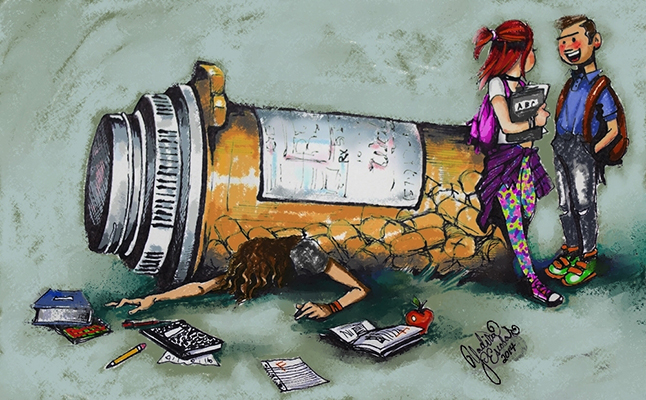Humans possess the largest number of neurons (more like around 86 billion actually) and with adequate surroundings and a healthy breakfast, most children will produce that desired academic excellence. Unfortunately a nutritional stimulus isnŌĆÖt exactly what some teachers are suggesting parents put into their kids mouths. When a student canŌĆÖt sit perfectly still in a chair for several hours, the traditional method of signing them up for counseling is too often criticized as inefficient and costly. Instead of focusing on the proper scholarly environment that is flexible enough to adapt to each childŌĆÖs unique pattern of learning a trip to the drugstore is advised.
It is not surprising to learn that the vast majority of these chemically sedated students come in from poor neighborhoods and low income families. A childŌĆÖs psychology is very fragile and will inevitably catch the distressing anxiety of struggling parents who are trying to make ends meet. The consequences of growing up in a violent neighborhood, seeing quarreling parents deteriorate under the pressure of pilling bills and mortgages plus even enduring periods of hunger sometimes manifests itself as ADHD (attention deficit hyperactivity disorder) in the classroom.
Ever since it was first classified as a mental disorder in the mid 80s it still isnŌĆÖt diagnosed through blood tests or anything similar, a simple checklist is used. We have to take their word for it. Not only does this human evaluation favor massive frauds, like college students at exam time faking the disease in order to be prescribed for Ritalin or Adderall. It wrongly treats many healthy minded children that simply disturb or annoy teachers.
The State Department of Education asks schools to have at least 1 licensed nurse operating at all times. This nurse administers daily the drugs and medications students are required to take, if the child presents a written permission from a parent then they may administer their own medication for chronic conditions. It isnŌĆÖt right when the school, not the doctor, jumps to the conclusion that a specific child needs drugs.
These are short-term solutions to deeper, underlying problems. The issue will not be solved by flipping through another revised edition of medical catalogues, but by bravely facing our social problems. The extensive arsenal of drugs like Prozac, Xanax or lithium has yet to prove long term results in their patients. They are being prescribed too liberally to children that are simply being overly stimulated by our fast-paced, excitable and stressed out cities. Not everyone learns at the same pace, and those are the kids that benefit greatly from that pharmaceutical help.
Administrating antipsychotics like Risperdal or dispensing Ritalin to students at lunchtime seems like the easy way out. Again, there are clear cases in which medications will bring order to a chemical imbalance but ADHD does not affect every child that is jittery in his seat. Our cultural and social woes will not dissipate under doctorŌĆÖs prescriptions and by refusing to address the real issue too many children are being wrongly sedated.
Reports reveal a horrifying reality: 3 million children in this country are taking drugs to concentrate at school. If at least these heavy narcotics could produce better grades then perhaps the achievements could justify the extreme sacrifice. Actually, in spite of it all, school test scores repeatedly rank the Unites States below many countries including Russia, the Czech Republic and Korea.
This school yearŌĆÖs price tag on each student was raised up to $11,810ŌĆ”and by late 2014 expenditure per student will be even heftier; $ 12,281. Numerous schools throughout the years have protested and cried out for more money but the statistics prove that all those billions of dollars have not been enough to boost the learning capacity. The school system isnŌĆÖt adapting to the lifestyle and learning needs of modern children.┬Ā On top of everything money is not being spent wisely so the wrong sectors are benefiting their pockets while each new generation wastes its most precious years without learning essential life skills.
What sort of example is our society in turn showing these children who later as adults confess that at the time, by their private judgment they did not really need narcotics? Not only are we crushing the self-esteem of thousands of sound kids, we are also setting the wrong example that drugs offer quick solutions. With what morale do school administrations profess the slogan of ŌĆ£just say noŌĆØ? If prescription medication is alright for subjugating classroom behavior, then other recreational drugs, psychedelics or hallucinogens are acceptable when emotionally down and blue?
The inspiring, isolated cases of the few who were either taken off the unnecessary medications or once reaching maturity decided to pull the plug themselves have shed incredible light on the adverse side effects.┬Ā Deciding between the two options of one excitable and unfocused child or an addicted, suicidal child with paranoid delusions plagued with headaches doesnŌĆÖt seem like a difficult decision.
I donŌĆÖt believe drugging AmericaŌĆÖs future to be an answer the Founding Fathers would have proposed.┬Ā Instead of opiating students because of low grades, future educational practices should simply generate a different teaching approach to properly engage and integrate the struggling students. Addressing the social problem of poverty and thus the adjacent obstacle of dysfunctional households will eliminate perhaps more than half of all current yet avoidable medication addictions in minors.┬Ā
┬Ā
